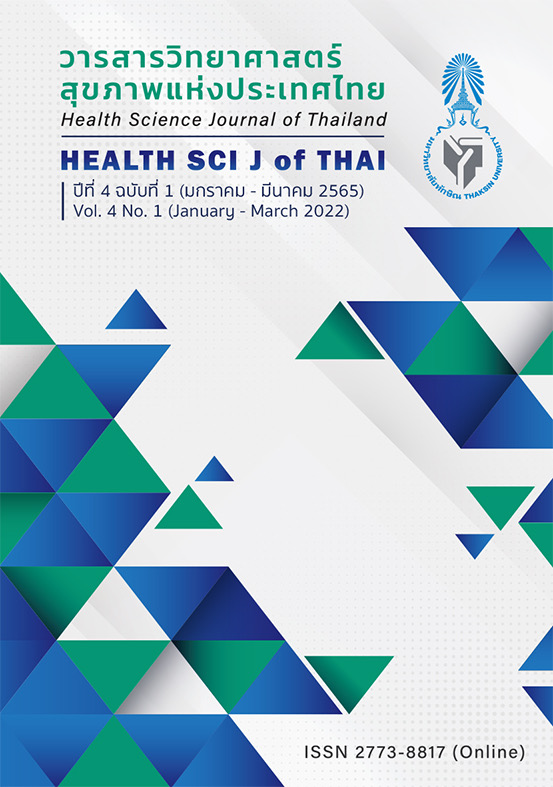Ability to Return to Work of Patients with Myocardial Infarction after Cardiac Rehabilitation in Phatthalung Hospital
Main Article Content
Abstract
The goal of cardiac rehabilitation in patients with myocardial infarction is to prevent complication and promote daily activity living. This descriptive study aimed to study the ability to return to work and associated factors after cardiac rehabilitation at Cardiac Rehabilitation Unit, Phatthalung Hospital. As a result, 113 samples were patients who were myocardial infarction, aged 65 years old or under and had been working. The data were derived from medical records and questionnaires, including Duke Activity Status Index (DASI, Thai version), Hospital Anxiety and Depression Scale (Thai HADS), and physical activity by six minute-walk-test walking (6 MWT). The data were analyzed using descriptive statistics, Chisquare test, Fisher exact test, and Paired t-test. The results showed that 88.49% of patients had ability to return to work. The factors significantly associated with the ability to return to work (p-value < 0.05) were sex, age, occupation, income, type of treatment, Ejection Fraction (EF), smoking, alcohol drinking, exercise before and after cardiac event, chest discomfort after treatment, level of physical activity by DASI, and 6-minute walk. Therefore, cardiac rehabilitation program should be assigned to patients with myocardial infarction, including those factors in order to increase the ability to return to work among patients.
Article Details

This work is licensed under a Creative Commons Attribution-NonCommercial-NoDerivatives 4.0 International License.
References
Ji H, Fang L, Yuan L, Zhang Q. Effects of exercise-based cardiac rehabilitation in patients with acute coronary syndrome: A meta-analysis. Med Sci Monit 2019; 25: 5015-27.
Chaiwanichsiri D. Cardiac Rehabilitation. In: Chaiwanichsiri D, Kitisomprayoonkul W, editors. Rehabilitation Textbook. Bangkok: Chulalongkorn University Publisher; 2009. (In Thai)
Linda L, Linsey A, Alice D, Jingzhou H. Exercise-based cardiac rehabilitation for adults with stable angina. Acta Med Scand Suppl 2018; 413: 18-61.
Palatsi I. Feasibility of physical training after myocardial infarction and its effect on return to work, morbidity and mortality. Acta Med Scand Suppl 1976; 599: 7-84.
Niramayee P, Arun M, Nivedita P. Impact of Cardiac Rehabilitation on Functional Capacity and Physical Activity after Coronary Revascularization: A Scientific Review. Journal of the American College of Cardiology 2016; 20(1): 94-8.
Long L, Anderson L, Dewhirst AM, He J, Bridges C, Gandhi M, Taylor RS. Exercise-based cardiac rehabilitation for adults with stable angina. Cochrane Database Syst Rev 2018; 2(2): 11-2.
Speziale G, Bilotta F, Ruvolo G, Fattouch K, Marino B. Return to work and quality of life measurement in coronary artery bypass grafting. Eur J Cardiothorac Surg 1996; 10(10): 852-8.
Intarakamhang P, Penkitti N, Pibulnakarintr A, Khunadorn F. The result of phase 1 cardiac rehabilitation and follow-up performance of the patients following open heart surgery at Pramongkutklao Hospital. J Thai Rehabil 1998; 8(2): 188-98. (In Thai)
Saowakontha P, Kantaratanakul V, Jitpraphai C. Return to work and sexual activity in cardiac patients after cardiac surgery. J Thai Rehabil 2000; 10(2): 73-9. (In Thai)
Jitardhan K, Kobkitsumongkol K, Uaaree P, Sangmanee S, Sanjaroensuttikul N. Factors relating to the return to work of the patients Post Open Heart Surgery. J Thai Rehabil 2011; 21(2): 43-9. (In Thai)
Labour Protection Division Thailand. Fact sheets: Labour Protection 2541. [Internet]. 1998 [Cited in 10 May, 2021]. Available from: https://www.labour.go.th/index.php/labor-law/category/5-laws-labor-3.
Aueari P, Kobkijsumongkol K. Common Problems in Cardiac Rehabilitation. In: Kantharattanakul W, editor. Cardiac Rehabilitation textbook. Nonthaburi: Apisara Intergroup Publisher; 2005. (In Thai)
Harnpadungkij K. 6-Minute Walk Test. J Thai Rehabil Med 2014; 24(1): 1-4.
Bumrungsk W. Physical Activity. In: Koonchorn Na Ayudhya R, editor. Cardiac Rehabilitation 2 textbook. Bangkok: Hason Printing; 2009. (In Thai)
Nilchaikovit T, Lortrakul M, Phisansuthideth U. Development of Thai version of Hospital Anxiety and Depression Scale. Journal of the Psychiatrist Association of Thailand 1996; 41(1): 18-30.
The Heart Association of Thailand under the Royal Patronage of H.M. the King. Fact sheets: Guideline for cardiac rehabilitation in patient heart disease. [Internet]. 2012 [Cited 1 Decemboer, 2012]. Available from: http://www.thaiheart.org/images/column_1291454908/RehabGuideline.pdf.
Jiang Z, Dreyer R, Spertus J. Factors Associated Return to Work After Acute Myocardial Infarction in China. JAMA Netw Open 2018;1(7): e184831.
Mustafah N, Kasim S, Isa M, Latif L. Predicting return to work following a cardiac event in Malaysia. Journal of Occupational Rehabilitation 2017; 58(4): 481-8.
Reibis R, Salzwedel A, Abreu A. The importance of return to work: How to achieve optimal reintegration in ACS patients. European Journal of Preventive Cardiology 2019; 26(13): 204748731983926.
Todd IC, Wosornu D, Stewart I, Wild T. Todd IC, et al. Cardiac rehabilitation following myocardial infarction: A practical approach. Sports Med 1992; 14(4): 243-59.
Simchen E, Naveh I, Zitser-Gurevich Y, Brown D, Galai N. Is participation in cardiac rehabilitation programs associated with better quality of life and return to work after coronary artery bypass operation?
The Israeli CABG Study. Isr Med Assoc 2001; 3(6): 399-403.
Suriya R, Jomkan W, Konsawan S, Promwichai P. Rating of perceived exertion and physical activity in patients with open heart surgery in Chiangrai Prachanukroh Hospital. Chiang Rai Medical Journal 2018;
(1): 85-97. (In Thai)
Hegwald J, Wegewitz UE, Euler U, Adams J, Fishta A, Heinrich P, et al. Interventions to support return to work for people with coronary heart disease. Cochrane Database Syst Rev. 2019; 14(3); 3-5.
Shephard RJ. Exercise in coronary heart disease. Sports Med 1986; 3(1): 26-49.


